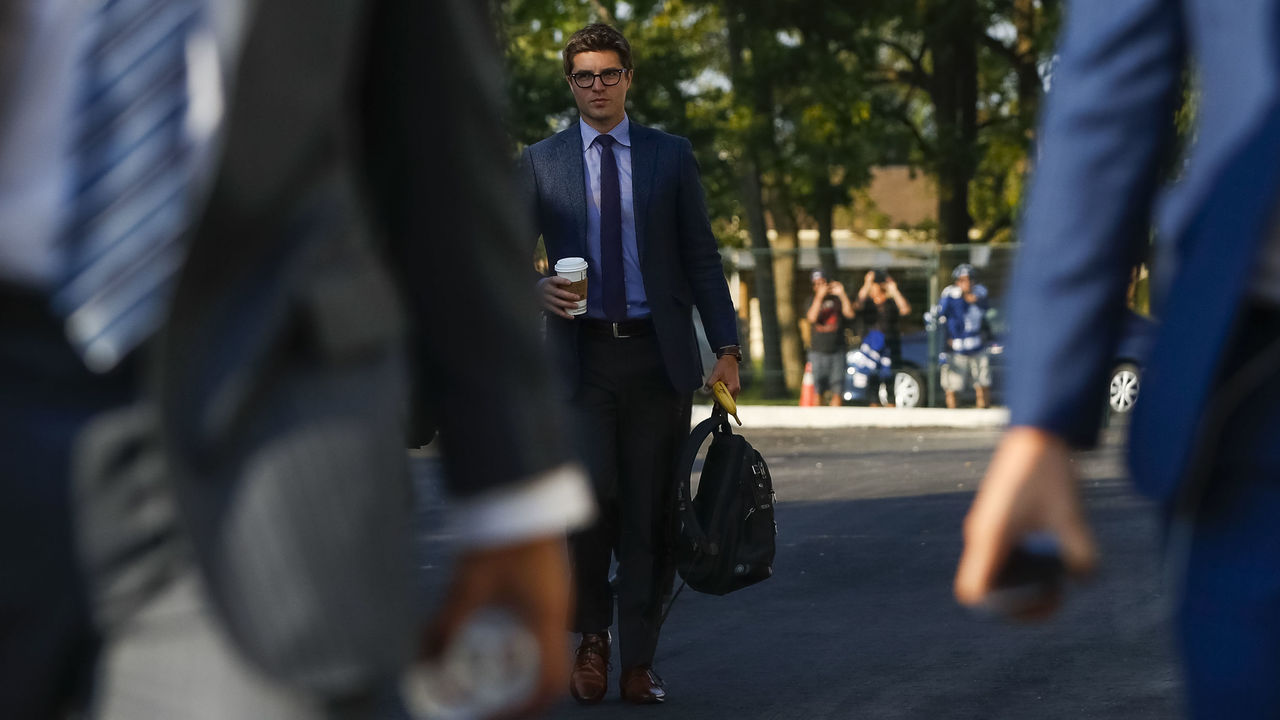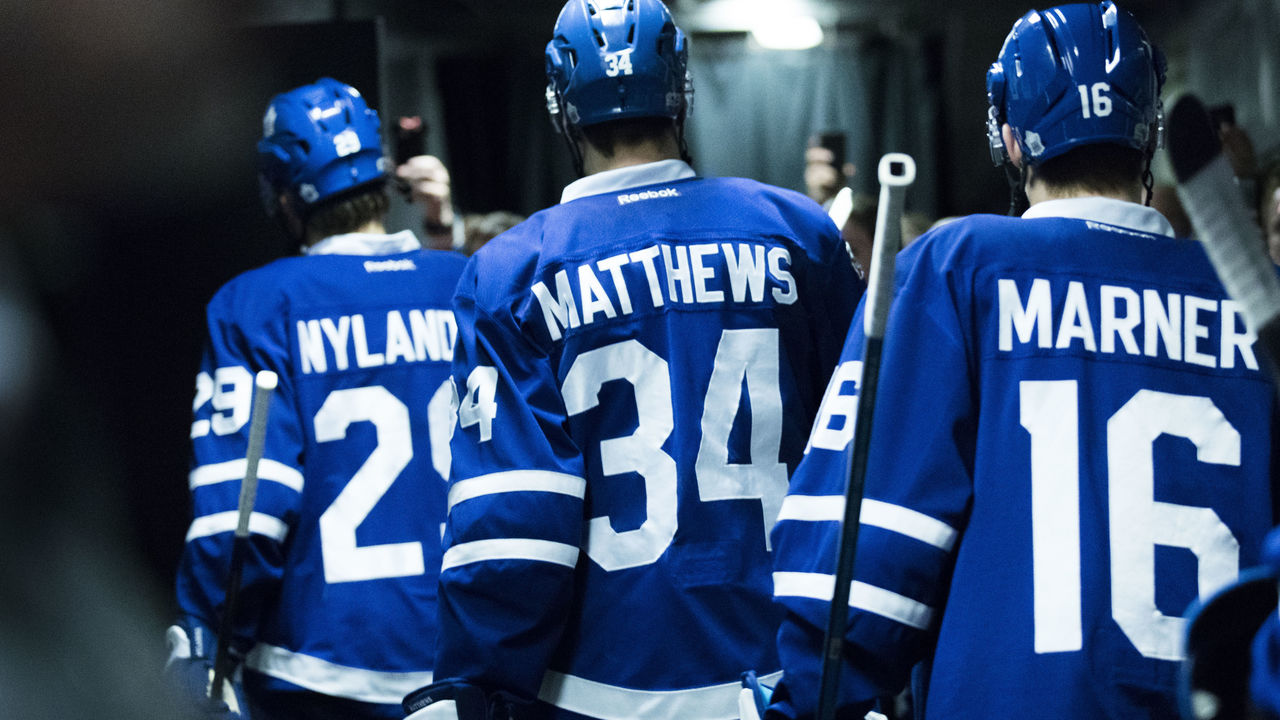Leafs win with Nylander deal, but Matthews, Marner talks loom large
"We can and we will."
Kyle Dubas uttered those five words in July when asked about the prospect of re-signing Auston Matthews, Mitch Marner, and William Nylander in the wake of John Tavares' monster free-agent contract.
No qualifiers. No hedging. Just straight to the point. The Maple Leafs' general manager laid it out in plain English: We can and we will.
It was the type of comment that - if things go sideways - can haunt a young GM in both the court of public opinion and in future negotiations with agents. Yet, with the first of those three stars signing a long-term deal this weekend, Dubas has begun living up to his promise.
"I know people were ready to jam that one down my throat," he said Saturday following the announcement of Nylander's six-year, $45-million extension.

For a second, Dubas let that subtle acknowledgment of the famous soundbite linger while sharing a laugh with reporters.
"But we’ll stick with it and that’s our goal," he continued, essentially doubling down. "We want this group to be together as long as we can possibly keep it together, and we hope that all of these guys can be career Leafs, especially this young core group of players that we have."
After a historically long standoff with Nylander, Dubas is understandably joyous. The 19-8-0 Leafs - one of the NHL's best teams through a third of the 2018-19 schedule - just added a difference-making skater coming off back-to-back 61-point campaigns. And it's also a win for Nylander, who stood his ground and will be paid handsomely through his mid-20s. He's set to reunite with his teammates ASAP and could make his season debut as early as Thursday.
Beyond that, the deal should have wide-reaching consequences for the Maple Leafs and the league as a whole.
What now for the Leafs?
By signing Nylander before Saturday's 5 p.m. ET deadline, the Leafs narrowly avoided two suboptimal scenarios: having a valuable asset sit out an entire year, or trading that valuable asset amid a very successful season.
Toronto had plenty of salary-cap space available and took full advantage by front-loading the contract so Nylander can cash in a quarter of the money between now and next training camp:
| YEAR | SALARY | BONUS | AAV |
|---|---|---|---|
| 2018-19 | $10.00M | $2.0M | $10.28M |
| 2019-20 | $700K | $8.30M | $6.96M |
| 2020-21 | $2.50M | $3.50M | $6.96M |
| 2021-22 | $2.50M | $3.50M | $6.96M |
| 2022-23 | $2.50M | $3.50M | $6.96M |
| 2023-24 | $2.50M | $3.50M | $6.96M |
(Chart info via TSN's Bob McKenzie and CapFriendly.com)
Still, even with Nylander's $10.28 million on the books this season, Dubas can add almost $5.15 million before hitting the upper limit of the cap. After paying out performance bonuses, the remaining money will likely be spent in some way, shape, or form by the Feb. 25 trade deadline.
"We'll still be able to potentially add to the group," the GM said Saturday, "and if we can strengthen the group, we will."
Again, Dubas is laughing in the short term. While it's a reasonable contract for both sides, Toronto's brass effectively won the battle by locking Nylander in at an average annual value of less than $7 million - no small feat considering negotiations stretched into December.
The hard work, on the other hand, is just beginning.
This coming summer alone, 13 players on the current Leafs roster are scheduled to hit free agency, including restricted free agents Matthews, Marner, and Nylander fill-in Kasperi Kapanen, along with unrestricted free agent Jake Gardiner, the polarizing top-four defenseman.
Some negotiations will be easy, while others should be contentious. Matthews and Marner, whose respective camps have put off contract talks until the offseason, will set the tone for the rest of the group. As the franchise's present and future, both will surely command eight figures per year.

Right now, many within the hockey world project Matthews around $12 million and Marner in the neighborhood of $10 million. For argument's sake, let's assume the goal-scoring center and the playmaking winger sign long-term extensions for a combined $22 million. That's a big chunk of the pie.
In that scenario, the Big Four - Tavares, Matthews, Marner, and Nylander - would be earning roughly $40 million, or half of the current upper cap limit. And if the '19-20 upper limit falls somewhere between $81.4 million and $85.4 million (as the NHL projects), this hypothetical but entirely realistic situation would leave Dubas with between $3 million and $7 million to fill out next year's roster. In other words, pennies.
It could get worse, too.
The smart bet is on Matthews (averaging a goal per game this season) and Marner (on pace for 115 points) continuing their upward trajectories. Even after their production inevitably tapers off a bit, the pair of 21-year-olds should still make compelling cases for gigantic, potentially disruptive raises that would likely put a tremendous amount of pressure on Dubas.
The Nylander standoff may ultimately be the most difficult negotiation of the three, but deals for Matthews and/or Marner will require some serious finessing by Dubas and assistant GM Brandon Pridham, the club's in-house cap guru.
The signing also means that suddenly, two bits of business by former GM Lou Lamoriello - Patrick Marleau's buyout-proof $6.25-million-per-year deal and Nikita Zaitsev's $4.5-million-per-year contract - are major headaches. And Gardiner, who could probably attract offers between $6 million and $7 million per season on the open market, looks as good as gone.
Unless, of course, president Brendan Shanahan's team-first mantra gains steam down the stretch and winning is enough to change minds.
Does Gardiner take a hometown discount in an effort to finish what he started in Toronto? Would Matthews take fewer dollars, therefore giving Marner a lower benchmark?
Maybe. But maybe not. Barring something unforeseen - like a salary-dumping trade - money's going to be hella tight for the Leafs. The potential discounts will be trims; not full financial haircuts. There will be hoops to jump through, and the possibility of an offer sheet (or two?) from another team is lurking in the background.
For now, "we can and we will" has legs. Nylander's under contract through 2023-24 and the other key pieces are lodged in position. Come summertime, however, all bets are off. There might even be a sequel to this standoff story.
What now for star-studded 2019 RFAs?
In the same way it creates a benchmark for the future Matthews and Marner extensions, Nylander's signing should benefit rival stars who are finishing up their entry-level contracts this season.
For a while, Jack Eichel's second contract of $10 million per year over seven seasons has been the high-water mark for elite forwards not named Connor McDavid. The next rung is Leon Draisaitl and his $8.5 million per year over eight, then David Pastrnak's $6.67 million over six, and then Nikolaj Ehlers' $6 million over seven.
Nylander etched out a new rung after waiting out his team until deadline day. In turn, he raised the bar, and will make roughly $300,000 more per season than his good pal Pastrnak. It may not seem like much in the grand scheme of things, but comparables are crucial during future contract talks.

Meanwhile, the 2019 RFA class - headlined by Patrik Laine, Mikko Rantanen, Brayden Point, Matthew Tkachuk, Sebastian Aho, Brock Boeser, Kyle Connor, Timo Meier, Charlie McAvoy, and Ivan Provorov - is stupidly talented and will reap the rewards of Nylander's standoff.
All of them have interesting cases, particularly Rantanen, given his offensive explosion this year, and Boeser, due to his injury history. How valuable is Tkachuk to Calgary's success? Will he agree to make north of $7 million but not quite Draisaitl money, establishing yet another rung?
One issue is that teams are mostly ill-prepared for this trend of young players earning this much, this soon. Previously, the typical high-end skater had to wait until their third contract to really see their bank account swell. Not anymore in a league dominated by rookies, sophomores, and players in their early 20s.
And, as the hockey world was reminded on a seemingly daily basis during the Leafs-Nylander saga, these RFAs don't usually qualify for salary arbitration. So, if the team and player aren't seeing eye to eye, the threat of sitting out - or in Nylander's case, actually sitting out - can become a real problem.
"I hope that, for the sake of everybody - the players, the teams, the game, in general - that teams and players are able to work together and have everybody there in time for training camp, and get everything sorted and done," Dubas said when asked if the Nylander situation might set a precedent across the league.
"I think it's great for the fans and it's great for the game, in general, to have every great, young player available and every exciting, young player available to be out here every night. We've deprived the fans of that for two months, so we're happy to get one back."
John Matisz is theScore's National Hockey Writer. You can find him on Twitter @matiszjohn.
HEADLINES
- Predators rally to hand reeling Maple Leafs another loss
- Report: Bergevin leaving advisor role with Kings to be Sabres' AGM
- Leafs spiraling, early Hughes impressions, more NHL hot topics
- Habs' Fowler collects 1st NHL shutout in win over Penguins
- Blackhawks' Nazar out approximately 4 weeks after puck to face